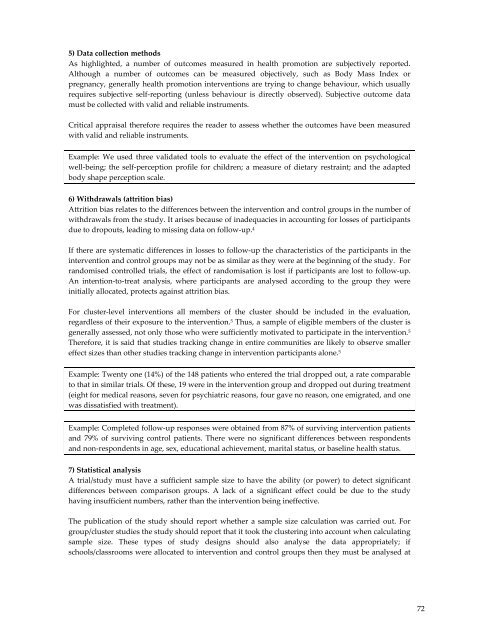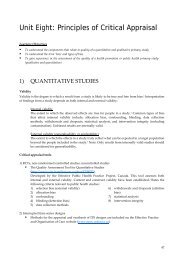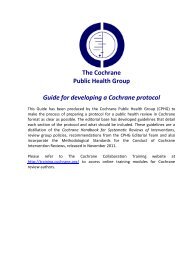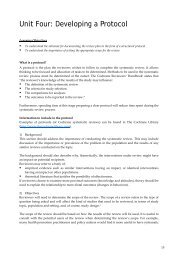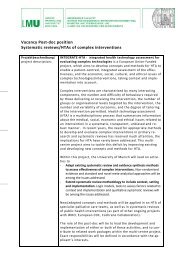Train the Trainer Course book - Cochrane Public Health Group
Train the Trainer Course book - Cochrane Public Health Group
Train the Trainer Course book - Cochrane Public Health Group
You also want an ePaper? Increase the reach of your titles
YUMPU automatically turns print PDFs into web optimized ePapers that Google loves.
5) Data collection methods<br />
As highlighted, a number of outcomes measured in health promotion are subjectively reported.<br />
Although a number of outcomes can be measured objectively, such as Body Mass Index or<br />
pregnancy, generally health promotion interventions are trying to change behaviour, which usually<br />
requires subjective self-reporting (unless behaviour is directly observed). Subjective outcome data<br />
must be collected with valid and reliable instruments.<br />
Critical appraisal <strong>the</strong>refore requires <strong>the</strong> reader to assess whe<strong>the</strong>r <strong>the</strong> outcomes have been measured<br />
with valid and reliable instruments.<br />
Example: We used three validated tools to evaluate <strong>the</strong> effect of <strong>the</strong> intervention on psychological<br />
well-being; <strong>the</strong> self-perception profile for children; a measure of dietary restraint; and <strong>the</strong> adapted<br />
body shape perception scale.<br />
6) Withdrawals (attrition bias)<br />
Attrition bias relates to <strong>the</strong> differences between <strong>the</strong> intervention and control groups in <strong>the</strong> number of<br />
withdrawals from <strong>the</strong> study. It arises because of inadequacies in accounting for losses of participants<br />
due to dropouts, leading to missing data on follow-up. 4<br />
If <strong>the</strong>re are systematic differences in losses to follow-up <strong>the</strong> characteristics of <strong>the</strong> participants in <strong>the</strong><br />
intervention and control groups may not be as similar as <strong>the</strong>y were at <strong>the</strong> beginning of <strong>the</strong> study. For<br />
randomised controlled trials, <strong>the</strong> effect of randomisation is lost if participants are lost to follow-up.<br />
An intention-to-treat analysis, where participants are analysed according to <strong>the</strong> group <strong>the</strong>y were<br />
initially allocated, protects against attrition bias.<br />
For cluster-level interventions all members of <strong>the</strong> cluster should be included in <strong>the</strong> evaluation,<br />
regardless of <strong>the</strong>ir exposure to <strong>the</strong> intervention. 5 Thus, a sample of eligible members of <strong>the</strong> cluster is<br />
generally assessed, not only those who were sufficiently motivated to participate in <strong>the</strong> intervention. 5<br />
Therefore, it is said that studies tracking change in entire communities are likely to observe smaller<br />
effect sizes than o<strong>the</strong>r studies tracking change in intervention participants alone. 5<br />
Example: Twenty one (14%) of <strong>the</strong> 148 patients who entered <strong>the</strong> trial dropped out, a rate comparable<br />
to that in similar trials. Of <strong>the</strong>se, 19 were in <strong>the</strong> intervention group and dropped out during treatment<br />
(eight for medical reasons, seven for psychiatric reasons, four gave no reason, one emigrated, and one<br />
was dissatisfied with treatment).<br />
Example: Completed follow-up responses were obtained from 87% of surviving intervention patients<br />
and 79% of surviving control patients. There were no significant differences between respondents<br />
and non-respondents in age, sex, educational achievement, marital status, or baseline health status.<br />
7) Statistical analysis<br />
A trial/study must have a sufficient sample size to have <strong>the</strong> ability (or power) to detect significant<br />
differences between comparison groups. A lack of a significant effect could be due to <strong>the</strong> study<br />
having insufficient numbers, ra<strong>the</strong>r than <strong>the</strong> intervention being ineffective.<br />
The publication of <strong>the</strong> study should report whe<strong>the</strong>r a sample size calculation was carried out. For<br />
group/cluster studies <strong>the</strong> study should report that it took <strong>the</strong> clustering into account when calculating<br />
sample size. These types of study designs should also analyse <strong>the</strong> data appropriately; if<br />
schools/classrooms were allocated to intervention and control groups <strong>the</strong>n <strong>the</strong>y must be analysed at<br />
72


